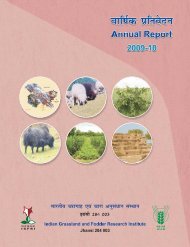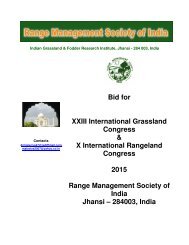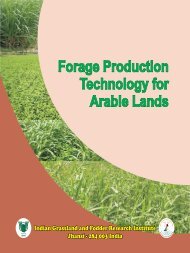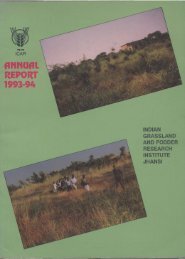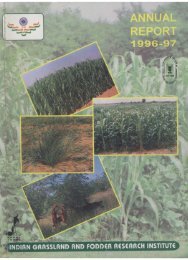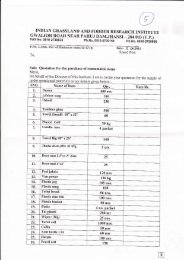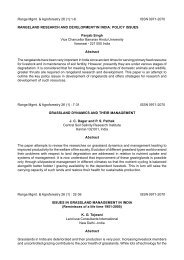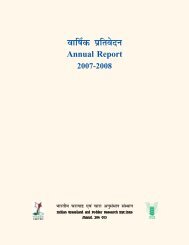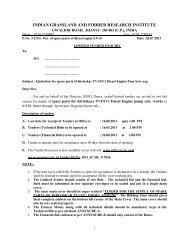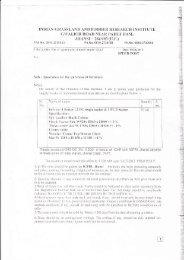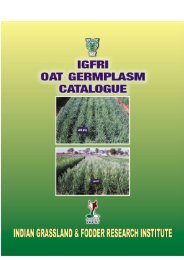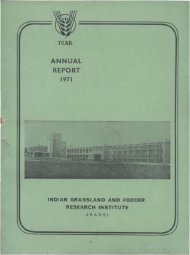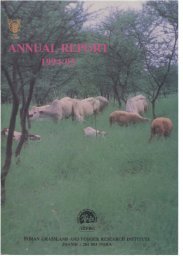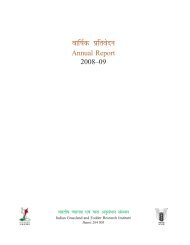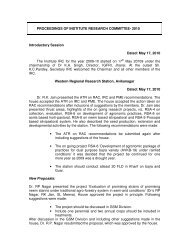IGFRI Vision 2050 - Indian Grassland and Fodder Research Institute ...
IGFRI Vision 2050 - Indian Grassland and Fodder Research Institute ...
IGFRI Vision 2050 - Indian Grassland and Fodder Research Institute ...
You also want an ePaper? Increase the reach of your titles
YUMPU automatically turns print PDFs into web optimized ePapers that Google loves.
<strong>Vision</strong> <strong>2050</strong><br />
1. Context<br />
Agriculture is the mainstay of the <strong>Indian</strong> economy <strong>and</strong> contributes nearly 14.1<br />
per cent of GDP (Economic survey, GOI 2012-13 base year 2004-05), as about<br />
65-70 per cent of the population is dependent on agriculture for their<br />
livelihood. Livestock production is backbone of <strong>Indian</strong> agriculture<br />
contributing 4% to national GDP <strong>and</strong> source of employment <strong>and</strong> ultimate<br />
livelihood for 70% population in rural areas. Despite taking great strides in<br />
addressing poverty, there remains a distinct rural-urban divide <strong>and</strong> India's<br />
emerging image as a global economic force sits uncomfortably with the harsh<br />
reality of its human development statistics. Contribution of livestock to<br />
agriculture sector GDP has been steadily increasing. The dem<strong>and</strong> for livestock<br />
products has shown an increasing trend, which is driven by sustained economic<br />
growth, rising incomes <strong>and</strong> urbanisation.<br />
Livestock is symbolic to wealth <strong>and</strong> power across civilizations for centuries.<br />
India is blessed with diversified type of livestock. Its livestock sector is one of<br />
the largest in the world. It has 56.7% of world's buffaloes, 12.5% cattle, 20.4%<br />
small ruminants, 2.4% camel, 1.4% equine, 1.5% pigs <strong>and</strong> 3.1% poultry. The<br />
importance of livestock in <strong>Indian</strong> agriculture is well recognized. Livestock not<br />
only provides food security through supply of milk, meat <strong>and</strong> self-employment<br />
of both men <strong>and</strong> women but also plays an important role for poverty alleviation<br />
of smallholder livestock farmers. The livestock are less affected by the climate<br />
th<br />
change <strong>and</strong> its growth is also higher than agriculture. In 11 plan the average<br />
growth of livestock sector was 4.1 while it was 3.6 for agriculture as a whole. The<br />
growth in livestock sector is also dem<strong>and</strong>-driven, inclusive <strong>and</strong> pro-poor.<br />
Incidence of rural poverty is less in states where livestock accounts for a<br />
sizeable share of agricultural income as well as employment. In India, livestock<br />
production system is primarily characterized by low input as well as low<br />
output. The livestock population is increasing <strong>and</strong> accordingly its feed<br />
requirements are also increasing. There is urgent need to meet the dem<strong>and</strong> of<br />
increasing number of livestock <strong>and</strong> also enhance their productivity for which<br />
availability of feed resources have to be increased. Almost all the grassl<strong>and</strong>s<br />
<strong>and</strong> grazing areas are devoid of quality legumes in enough quantity. To<br />
compensate low productivity farmers generally maintain more number of<br />
animals which obviously increase the pressure on limited fodder resources.<br />
<strong>Fodder</strong> scarcity makes dairying uneconomical <strong>and</strong> unattractive as an income<br />
generation activity among the poor farmers of the country. Looking at the vast<br />
gap between the dem<strong>and</strong> <strong>and</strong> supply position, it becomes necessary to put<br />
adequate efforts to transfer the potential technologies developed by various<br />
research organization in the country to farmer's field in order to increase the<br />
1



